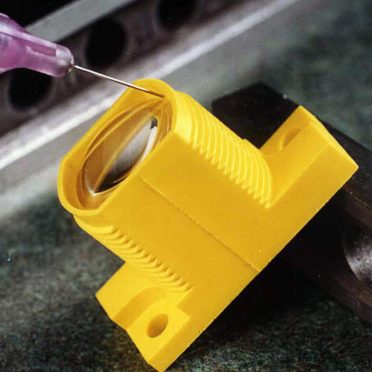Optics engineers commonly require optical adhesives to bond components together during optical assembly, lens and prism bonding, optical element positioning and fixturing, and fibre-optic assembly. Every adhesive has its own strengths and limitations, which can make it challenging to determine which is the most suitable material for the task at hand. Selecting an adhesive requires careful consideration, weighing up the properties of the material according to the requirements of the application, balanced against the process demands. Optical transmission and perhaps refractive index are often primary considerations if the adhesive is to be in the light path, but there are a number of other things to think about.
Optical adhesive properties
To some extent, all adhesives shrink in volume during curing. This can cause stress on the parts and can cause focusing and alignment issues during assembly. To overcome this, you can opt for a material with low shrinkage. Standard epoxy adhesives typically have a shrinkage of around 3-5%. There are special UV curing optical adhesives that shrink 0.2-0.4%, whilst maintaining optical clarity. The hardness and modulus of the cured material may be important for the integrity and performance of the structure. For example, fibre-optic terminating adhesives may need to cure very hard in order to allow polishing and prevent fibre movement.
You should also consider outgassing — the release of volatile materials both during and post cure — when selecting an adhesive, if the condensing of these volatiles onto optical surfaces will lead to quality issues.

Curing and handling optical adhesives
The optics engineer should consider the curing method of the adhesive and how it will affect the speed and complexity of the project. UV curing adhesives cure in a few seconds, which can be beneficial if speed is a requirement for your production process. This rapid curing is useful during alignment or focusing, as the adhesive is quickly cured once the positioning process is complete, releasing complex jigs and fixtures for the next assembly. Two part optical epoxies take longer to cure than UV cured adhesives (minutes to days as opposed to seconds); they can be accelerated with heat, although the thermal excursion can induce stress into the parts during and post cure. Epoxies do offer high hardness, and good chemical and temperature resistance (potentially 350°C for short periods), and can resist multiple autoclaving cycles. Products from our Opti-tec and Polytec PT ranges include suitable optical epoxies.
The viscosity of the adhesive is also a factor. Will the adhesive be required to fill a gap; wick into a gap; or bridge a gap? If a two-part system is specified, mixing becomes a process concern. Special equipment may be needed to provide a repeatable homogeneous mix. Degassing may be required if the mixing process induces air that becomes an unacceptable artefact in the light path.
UV curable acrylate adhesives are a popular choice for optics applications because they are easy to use and offer a rapid cure time. For example, low-stress, low movement UV curable optical assembly adhesives, such as from the Dymax OP optical assembly adhesives range, offer optics engineers options that cure in seconds, while still providing strength and clarity. Offering shrinkage as low as 0.1%, and high tensile strength bonds of 3,000 psi in a single component, this type of adhesive is a compelling option for many optics applications.
The wide range of options now available can make choosing the right optical adhesive for your application a challenging task. We welcome the opportunity to work with you on material selection and supply, as well as the associated application and curing equipment. Please get in touch.
